Ilkeston Corporation Tramways
History
Ilkeston Corporation's 3ft 6ins-gauge, overhead electric tramway had a rather protracted birth, powers being obtained on the 9th August 1899, though not without significant objections from local ratepayers, who were concerned — correctly as it turned out — about the viability of the enterprise. The corporation had 24 months from the granting of the tramway order to complete construction, but needed to seek an extension to the time limit, construction work only commencing on the 5th November 1901.
The corporation also obtained powers to construct and operate a municipal electric supply undertaking, but subsequently reached agreement with the Derbyshire and Nottinghamshire Electric Power Company (in 1901), for the latter to construct and supply electricity to both the tramway and town, a decision it would have cause to regret. Construction of the power station lagged significantly behind the tramway, such that the latter, which had itself taken a somewhat leisurely 12 months to build (quite a long time for a small system), then lay idle for another 6 months for want of power.
The system, which opened on the 16th May 1903, totalled just 3.78 miles, and was never extended; it took the form of a main line (built on the single line and passing loop principle), with a half mile branch and a short stub serving the depot. From the northern terminus at Church Rd, the main line ran southwards along Cotmanhay Rd to Ilkeston, then along Bath St and South St, where it turned southeastwards along Nottingham Rd, before once again turning southwards along Thurman Rd and Corporation Rd to a terminus at Hallam Fields Rd. The branch line, which was just over half a mile long, ran eastwards from Bath St along Station Rd to the Midland Railway's Ilkeston Town Station, whilst the stub line, which was barely 150 yards long, ran northeastwards from White Lion Square on South St, along Park Rd, where the depot was located.
Initial loadings were heavy, the corporation, at the behest of the manager, rather precipitately ordering four more tramcars, another decision it would come to regret, 13 vehicles being somewhat excessive for a such a small system. By early 1904, it was clear that demand had been significantly over-estimated, and so began a long, drawn-out battle to contain costs and thereby hopefully balance the books. The financial situation was worsened by the state of the track and the tramcars, both of which had been poorly constructed, necessitating, as early as 1908/9, significant expenditure, and if that wasn't enough, the power supply was less than satisfactory, frequently failing completely.
By the time of the Great War, and despite the best efforts of the corporation and various managers, the losses continued and the overall debt mounted. Like many other tramways around the country, the war soon led to a loss of men (and their skills), as well as shortages of spares and restrictions on purchasing such essential items as new track (a particular issue at Ilkeston). With the tramway incurring loss after loss, and with a significant outstanding debt that it had no chance at all of servicing, the council astonishingly managed to find a buyer for the tramway, probably to its great surprise.
The buyer was Balfour Beatty and Co, a company which specialised in promoting, purchasing, or otherwise acquiring interests in provincial tramways and electric supply companies up and down the country, a policy which would eventually see it control the following systems: 1909 (Dartford Council Light Railways; Dunfermline and District Tramways; Llandudno and Colwyn Bay Electric Railway; Llanelly Tramways; Luton Corporation Tramways); 1911 (City of Carlisle Electric Tramways); 1912 (Leamington and Warwick Electric Tramways; Mansfield and District Light Railway; Nottinghamshire and Derbyshire Tramways); 1914 (Cheltenham and District Light Railway); 1920 (Falkirk and District Tramways); and lastly, in 1922 (Wemyss and District Tramways).
BB&Co had also separately gained control of the Derbyshire and Nottinghamshire Electric Power Company, which now took over Ilkeston's electricity distribution network, the tramway system being formally passed to another of its subsidiaries, the Nottinghamshire and Derbyshire Tramways Company. The N&DTCo took over operation on the 30th June 1916, the transfer of ownership formally taking place on the 15th November 1916, though it was to be another 7 years before payment was completed.
The N&DTCo had originally had grand plans for an extensive network in the two counties in its title, and though it held powers to construct around 47 miles of tramway, it only ever managed to build a quarter of this, its main line from Ripley to Nottingham having only opened in July 1913. In acquiring the Ilkeston system, the N&DTCo no doubt saw a chance to expand its influence and to join the two systems up, even though they were built to different gauges.
Following the end of the Great War, the N&DTCo completely overhauled the ex-ICT tramcar fleet, with five of the vehicles ultimately being sent on to other BB&Co systems, a clear indicator of what the N&DTCo thought about having 13 tramcars for such a small system. Quite why the corporation had kept these vehicles instead of selling them on whilst they were still new — and saleable — is unclear.
In 1922, the N&DTCo went to the trouble of acquiring powers to not only link its two tramways — between Heanor and Cotmanhay — but also, to convert the Ilkeston system to standard gauge. From a vantage point in the 21st Century, it seems quite perverse for the company to have pursued such an expensive proposal, which effectively involved the complete rebuilding and re-equipping of a system that had shown no signs whatsoever of turning a profit.
By this time however, BB&Co had begun to introduce motorbus services into the area — via a new motorbus-operating subsidiary, initially called the 'General', but soon renamed the 'Midland General Omnibus Company' — the new company sharing a depot with the N&DTCo at Langley Mill. Events therefore overtook the tramway expansion plans, the N&DTCo being left with an old and frankly worthless asset that ran down the centre of Ilkeston's busy and narrow roads, and which was viewed by the general populace as an anachronistic nuisance.
It was now only a matter of time before the life-expired system would be closed, the only question being when this would be and what type of traction would replace the trams. The answer came in 1928 when the N&DTCo secured powers to convert its main line and the Ilkeston system to trolleybus operation, a much-favoured form of traction at this time, especially where the tramway owner also owned the electricity generation infrastructure, as was the case here. As part of the act, the N&DTCo's title was formally changed to the Nottinghamshire and Derbyshire Traction Company, to reflect the impending transition.
Track lifting on the Ilkeston system commenced on the 22nd December 1930, the last tram running just over two weeks later on the 8th January 1931. Motorbuses took over the services as an interim measure, operating for exactly one year before they were displaced by the N&DTCo's new trolleybuses on 7th January 1932.
Uniforms
Several photographs taken on the opening day clearly show staff wearing informal attire, but with script-lettering grade badges on their own informal caps, suggesting that uniforms had yet to be delivered. Uniforms, when they did arrive, took the form of double-breasted, 'lancer-style' tunics with five pairs of buttons (narrowing from top to bottom) and upright collars; the latter carried individual 'I C T' initials on the bearer's right-hand side and an employee number on the left-hand side. The uniforms were of grey serge with red piping; the pattern of button is unclear, but as marked 'tramway' buttons are unknown, it is possible that a standard brass municipal button was used (see link). Caps were in a kepi style and carried standard, 'off-the-shelf', script-lettering grade badges — either Motorman or Conductor — possibly brass, above which an oval badge of unknown pattern was worn, more than likely involving a municipal device.
At some point, probably in the late Edwardian era, conductors jackets were changed to a single-breasted design with five buttons, two breast pockets (with button closures), upright collars and epaulettes (again with button closures). The collars probably bore the same insignia as previously, though photographs do not allow this to be stated with certainty. The kepi-style caps were also replaced, very probably at the same time (i.e., the late Edwardian era), by a more modern military style of cap with a tensioned crown (top); these new caps continued to bear the same badges as the kepis they superseded. The oval cap badges however, appear to have been dispensed with some time before the Great War, leaving the script-lettering grade badge as the sole cap adornment.
Following the take-over of 1916, uniform policy appears to have broadly followed that of the Nottinghamshire and Derbyshire Tramways Company, i.e. single-breasted jackets for conductors and 'lancer-style' tunics for motormen. More modern single-breasted jackets (with lapels) were certainly introduced for conductors some time before closure, and may well have been used for motormen too, though this cannot be discerned on surviving photographs as the subjects are invariably pictured wearing greatcoats. The military-style caps were also superseded, presumably at the same time, by soft-topped caps with glossy peaks; these new caps continued to carry the same script-lettering grade badges as their predecessors.
Motormen and conductors were also issued with heavy-duty, double-breasted greatcoats with five pairs of buttons and high, fold-over collars; like the tunics worn underneath, the collars initially carried individual 'I C T' initials on the bearer's right-hand side and an employee number on the left-hand side, though this practice seems to have lapsed in later years.
Inspectors initially wore single-breasted jackets with lapels; the collars appear to have borne metal 'I C T' system initials on the bearer's right-hand side, with the left-hand side left plain. Caps were in a kepi-style and bore the same oval cap badge worn by tramcar crews, but with a script-lettering grade badge — Inspector — beneath, which photographs again suggest was metal, in contrast to the overwhelming majority of UK tramway systems, which used embroidered insignia for senior staff.
In common with most UK tramway operators, Ilkeston employed female staff (as conductresses) during the Great War (from 1916 onwards) to replace men lost to the armed services. These ladies were certainly issued with jackets and long matching skirts, though precisely what form the jackets took is unknown, as surviving photographs only show them in long single-breasted greatcoats with prominent buttons and high, fold-over collars, the latter being devoid of insignia. Headgear took the form of a baggy cap with a stiff glossy peak; these bore standard, 'off-the-shelf' script-lettering Conductor badges.
Further reading
For a history of the tramway, see: 'Ilkeston Tramways - Derbyshire's First Electric Tramway' by Barry M Marsden; The Ilkeston and District Local History Society (2002).
Images
Motormen and conductors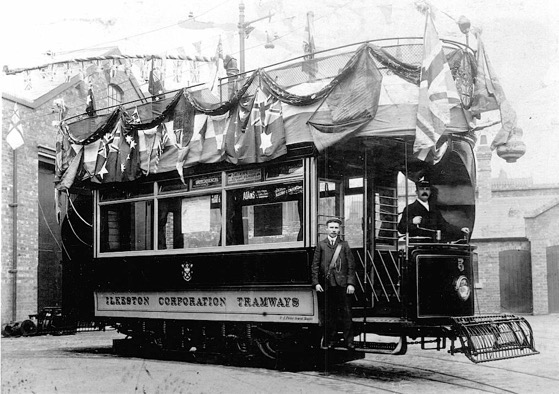
Tramcar No 5 stands outside the depot, in pristine condition and bedecked for the opening ceremony — photo undated, but more than likely taken on the morning of the 16th May 1903. Photo courtesy of the Barry Marsden Collection.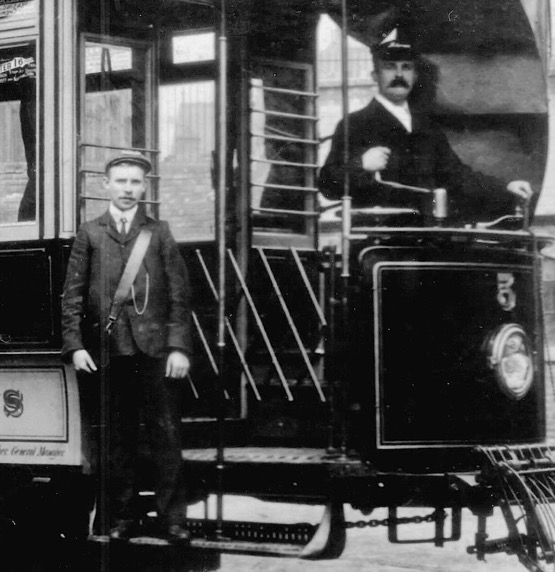
A blow-up of the above photo showing the conductor and motorman, both of whom are wearing, with the sole exception of script-lettering grade badges, informal attire. Uniforms were presumably late in arriving, an astonishing fact given that the trams had been waiting around for many months for the electricity supply to finally be switched on.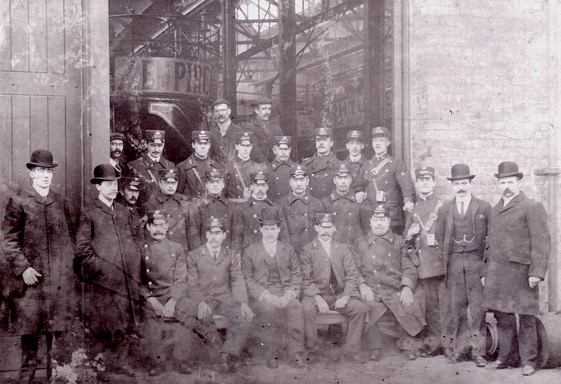
Probably the entire operating staff, together with various officials and local luminaries, pose for a formal shot outside the tramcar depot in Park Road — photo undated, but probably taken following delivery of the uniforms, almost certainly in the summer of 1903. There are eight motormen, eight conductors and two inspectors. Photo courtesy of the Barry Marsden Collection.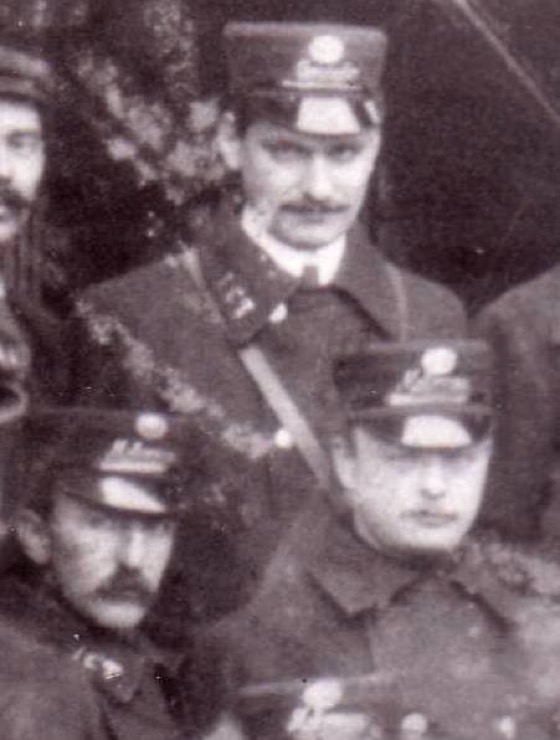
A blow-up of the above photo showing a conductor (top) and two motormen. The kepi-style caps carry script-lettering grade badges and an oval badge of unknown pattern; the 'I C T' collar initials are easily made out.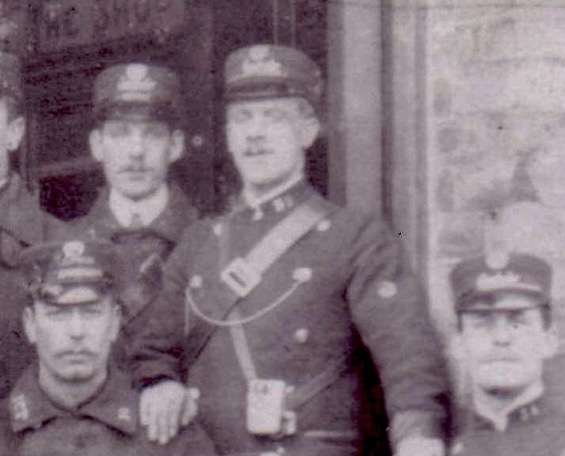
Another blow-up of the staff photo above, this time showing two conductors (back) and two motormen. The subject in the middle is one of the few depicted who is not wearing a greatcoat, thus revealing his 'lancer-style' tunic. The employee numbers on the bearers' left-hand collars (of both tunics and greatcoats) are also easily made out. 
General pattern script-lettering cap badges — Motorman and Conductor — brass, of the type used by Ilkeston Corporation Tramways, though it is currently unclear what material Ilkeston used (i.e., brass or nickel). Author's Collection.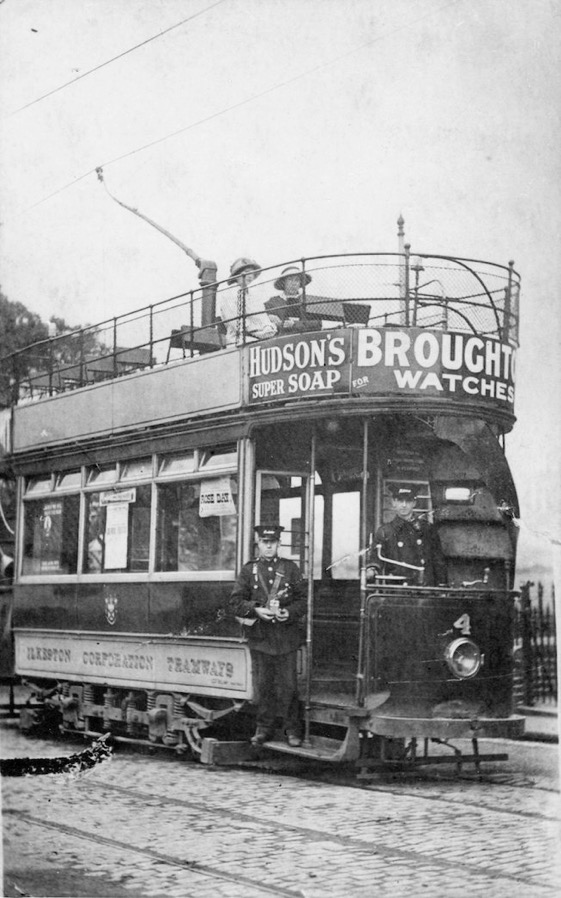
The crew of Tramcar No 4 captured at the terminus at Cotmanhay — although undated, the General Manager's name on the rocker panel would appear to be 'L F Bellamy', which would date the photo to between 1913 and 1916. Author's Collection.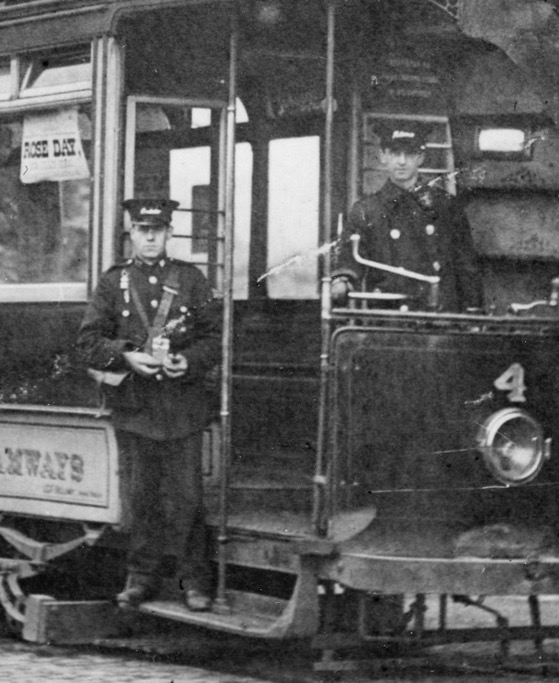
A blow-up of the above photo showing the conductor and motorman, the former in single-breasted jacket with upright collars and the latter in a double-breasted greatcoat. Both men are wearing military-style caps with script-lettering grade badges, but no oval badge above.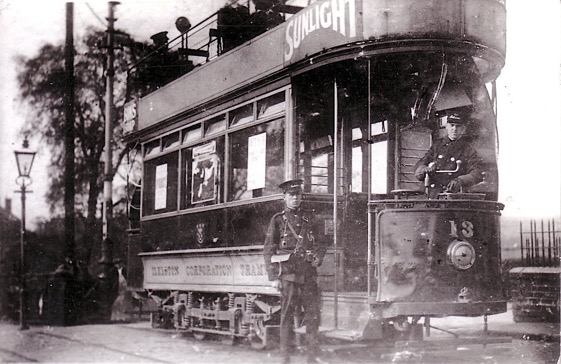
Another shot taken around the same time, almost certainly during the early part of the Great War, and at the same location, Cotmanhay. Photo with acknowledgement to the Midland General Omnibus Company website.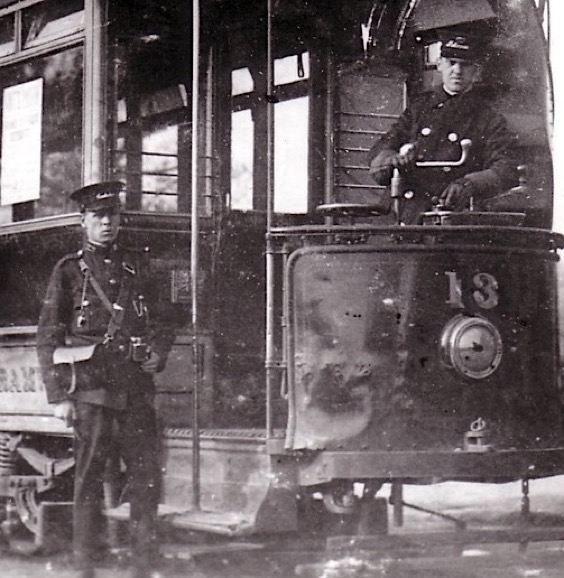
A blow-up of the above photo showing the conductor and the motorman (Mr J D Turton).
Senior staff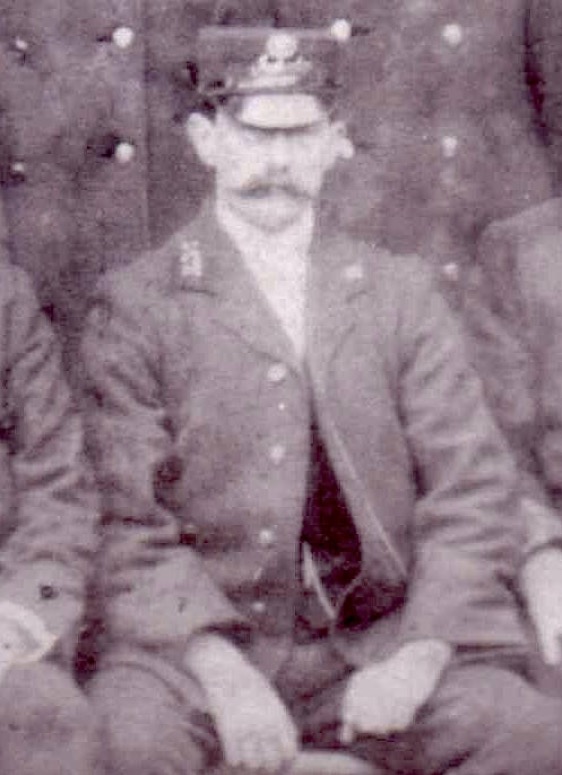
A blow-up of the staff photo above showing one of the inspectors. Somewhat unusually for a UK tramway system, his script-lettering grade badge would appear to be metal (possibly brass), as opposed to the embroidered hat bands used on most systems.
Script-lettering grade badge of the type probably worn by Ilkeston inspectors, at least during the early years — brass. Author's Collection.
Female staff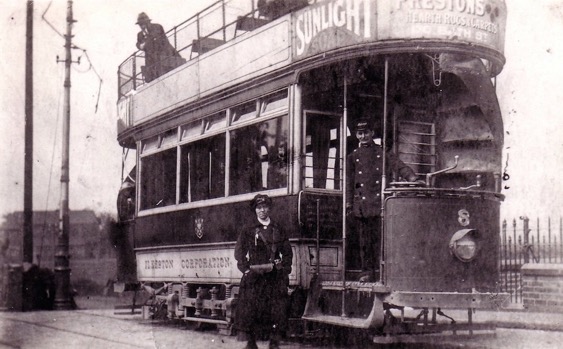
The crew of a rather neglected-looking Tramcar No 8 pose for the cameraman at Cotmanhay in 1917. Author's Collection.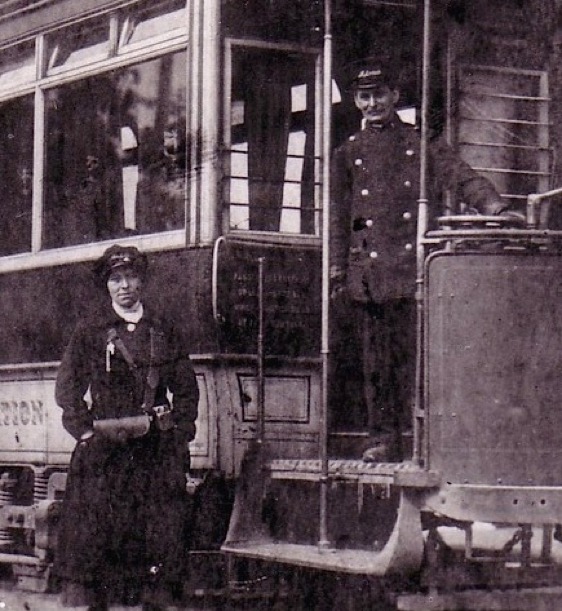
A blow up of the above photo showing the conductress; she is wearing a single-breasted coat and a baggy cap, the latter with a glossy peak and a script-lettering grade badge (Conductor).